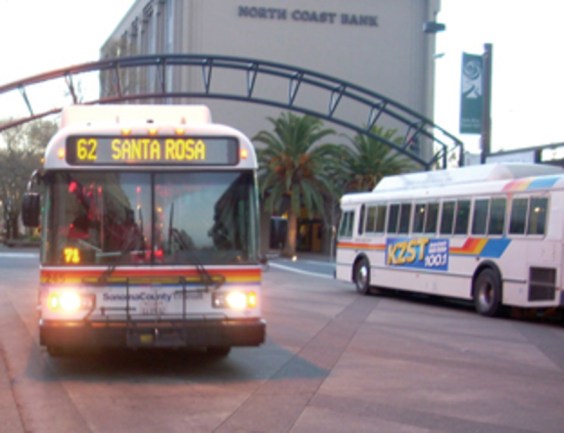Miami's conversion of HOV lane space to new high-occupancy toll (HOT) lanes as part of the federal Urban Partnership program, which also prompted New York City's congestion pricing push, is cutting travel times for local transit and boosting use -- but overall bus ridership in the corridor has stayed static, according to a new report from the U.S. DOT.
 Miami's 95 Express HOT lanes, at left, with regular traffic at right. (Photo: SF Biz Jrnl)
Miami's 95 Express HOT lanes, at left, with regular traffic at right. (Photo: SF Biz Jrnl)The U.S. DOT, working alongside the National Bus Rapid Transit Institute, found that the city's 95 Express project has trimmed travel times by as much as two-thirds for users of the bus service on northbound HOT lanes.
But the picture is murkier for transit in Miami's I-95 corridor, which saw static levels of "mode share" (transportation-speak for the percentage of area travelers using a particular option) between 2008 and 2009.
Overall bus ridership in the I-95 corridor decreased by 4.6 percent, even as 95 Express bus ridership rose by 30 percent during the same period, according to the report.
Why did broad transit use fall while single-occupany vehicles flocked to the new HOT lanes? Service cuts and fare hikes of as much as 33 percent for monthly transit passes played a big role, the U.S. DOT found, as did the economic recession and lower gas prices that made auto travel more appealing to locals.
However, the report did contain some positive signals for transit mode share in Miami's I-95 area. Half of the bus riders surveyed by the U.S. DOT said they had switched over from car travel, "which suggests that the 95 Express bus service in general has had some success over time in attracting private auto users," the report stated.
Moreover, the U.S. DOT noted that 95 Express buses constitute just one-fifth of the corridor's total transit ridership -- meaning that even a 30-percent increase in popularity can't carry the whole system. That could change this month, however, with the current northbound 95 Express HOT lanes adding a southbound component and the state starting bus service connecting Miami-Dade with Broward County, its northern neighbor.





